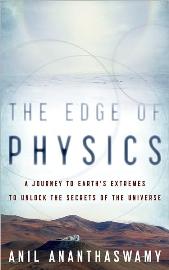
The Edge of Physics: A Journey to Earth’s Extremes to Unlock the Secrets of the Universe
by Anil Ananthaswamy
 Barring apples falling on heads, physics isn’t often made tangible. But Anil Ananthaswamy aims to bring that most obscure and fundamental branch of science down to Earth. Devoting each chapter to the far-flung site of a vanguard experiment, Ananthaswamy meets – not to mention bunks, eats, drives, hikes and suffers extreme cold with – the men and women working to understand why the universe is the way it is.
Barring apples falling on heads, physics isn’t often made tangible. But Anil Ananthaswamy aims to bring that most obscure and fundamental branch of science down to Earth. Devoting each chapter to the far-flung site of a vanguard experiment, Ananthaswamy meets – not to mention bunks, eats, drives, hikes and suffers extreme cold with – the men and women working to understand why the universe is the way it is.
Directly observing experiments and briefly but expertly recounting key moments in the history of physics, Ananthaswamy explains how observations of distant galaxies and miniscule particles leads slowly toward knowledge of dark matter and the curvature of the universe, and ultimately, perhaps, to a unified theory of physics.
He begins at Mount Wilson, where Edwin Hubble – a jodhpur-wearing swaggerer who liked to be addressed as Major – showed Albert Einstein evidence that the universe wasn’t static. The high-altitude location gave cosmologists a clear view of the sky, though it’s since been somewhat obscured by the city growing below. From here Ananthaswamy travels the opposite direction, to a 2,341-foot-deep Minnesota iron mine that one worker says smells like an underground parking garage. There, scientists hope to detect the collision of dark-matter particles – acronym, WIMPs – with a nucleus of normal matter. It’s a hypothetical interaction so unlikely that one scientist, who has devoted his career to the search, describes the detection method as “a total crapshoot.”
The search for dark matter keeps Ananthaswamy moving to Lake Baikal in Russia, where scientists spend a few months each winter drilling holes in thick ice to drop “artificial eyes” into the pure water below. They’re looking for signs of a dark matter neutrino hitting a water molecule, which creates “tiny flashes of blue light.” The team works long hours, lives in bunk beds, uses a sauna to clean off since showers aren’t around, and chomps on pickles and sausages and swills vodka.
The South Pole is the most dramatic setting Ananthaswamy sees. There, walking a flight of stairs gets him winded, and he encounters hard-drinking hulks of men operating massive drills that dig holes deep enough to hold eight Eiffel Towers, again looking for obscure collisions between particles. The lab he compares to a cruise ship – entirely self-contained, in an ocean of ice. “One can almost visualize the curvature of the Earth here,” he writes, “such is the unbroken expanse.”
After treks up Hawaiian volcanoes and Chilean mountains and across South African plains, his last stop is the Large Hadron Collider, as “particle accelerators are the crown jewels of physics.” The collider creates conditions of the very young universe to answer all the big questions: what is dark matter actually made of? Are there extra dimensions? Can we find a theory of quantum gravity? In Geneva he sees a “graveyard of early particle detectors,” roads named after Nobel Laureates Marie Curie and Wolfgang Paul, and a six-foot statue of the Hindu god Shiva.
It’s both “anomalous and appropriate,” he writes, to see an image of the divine near a device that represents the height of empiricism. The juxtaposition is most stark at the collider, but Ananthaswamy encounters it repeatedly, from monks that share space on Mount Wilson, to the Hawaiians who initially opposed building telescopes on the sacred Mauna Kea, to the early South Pole explorers who regarded the spot of the future lab with reverence. And of course, the collider searches for the Higgs boson, sometimes called the God particle. The physicist Peter Higgs, an atheist nearing 80 years old, hopes to witness the discovery: “I’ll just have to ask my GP to keep me alive a bit longer.”
The proximity of the sacred and the scientific makes for some unease. The experimental physicists Ananthaswamy meets, working to find a reason for why things are as they are, “hate coincidences,” particularly the notion that particles behave the way they do because they must, because otherwise life wouldn’t exist. The “anthropic principle” at the center of some theories – like the “elegant” string hypothesis that supposes ours is one universe of countless unfit for life – is not so different from a belief in the divine. Both require, for all the detectors on all the mountaintops and mines and poles, a faith in the unseen.
Excerpt: “I stood and gazed at the new U.S. South Pole station, which replaced a geodesic dome dating from 1975 and was still being completed. It is a sleek two-storey block, clad in gunmetal-gray siding and chock-full of comforts. In fact, once inside the new station, it’s easy to forget just how far from civilization you are. People walk around in T-shirts and jeans, even shorts and flip-flops. The chefs in the galley serve breaded catfish, Chinese pork roast, and New York strip steak. Noticeboards carry messages advertising yoga sessions and a pub trivia game…. But step outside and you are reminded that everything at the South Pole is beholden to the snow. The residents fight a Sisyphean battle against relentless drifts, which pile up against any conventional structure and eventually bury it. The first station, built in 1957, is now more than 20 feet below the surface.”
Further Reading: The God Particle: If the Universe Is the Answer, What Is the Question? and The Trouble With Physics: The Rise of String Theory, the Fall of a Science, and What Comes Next
*Photo courtesy Image Editor.




Send A Letter To the Editors